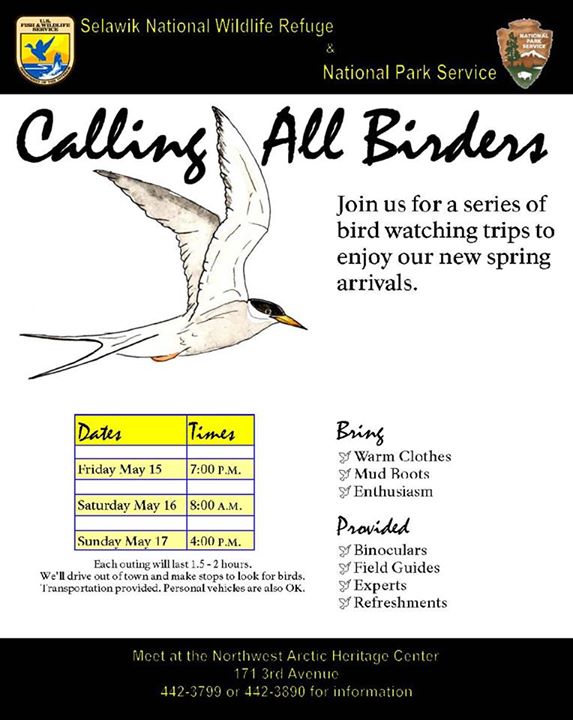Ice is going out in Kotzebue Sound, and birds are beginning to arrive in northwest Alaska. Both signify a change in seasons in this part of the Arctic. At this time of year, the shorebird crew that recently conducted studies in Cape Krusenstern National Monument (during 2010-2014) would have been arriving in Anchorage to begin preparations for a long field season at Krusenstern Lagoon.
During a typical season, crew members would meet a week or two before field work, usually for the first time, and would immediately begin to work as a team in order to complete important tasks that needed to happen in town. In addition to finalizing paperwork, preparations would involve testing and repairing important pieces of field gear that had been in storage all winter, such as camp stoves, air mattresses, and four season tents; shopping for field camp supplies and groceries (don’t forget the Pilot Bread!!); shipping pallets of food, supplies, and gear north via air cargo; and completing important training, such as bear and gun safety training and firearms qualification courses.

This is what shopping for food for four hungry crew members for 56 days looks like when Fred Meyer runs out of bush order boxes. Photo: Jesse Coleman

Cargo shipments can take some time. It’s always a relief when all of our food boxes, camp gear, and research supplies are stacked on their pallet and ready for the flight. Photo: Megan Boldenow
As the shorebird crew was hard at work in Anchorage, the first of the spring migrants would be arriving in northwest Alaska to begin establishing territories and building nests. Waterfowl generally return to the tundra from the wintering grounds earlier than shorebirds. They use polynyas (permanently open water in pack ice) and offshore leads until the ice retreats; and they also take advantage of other areas with early open water, such as places along the shoreline with freshwater input. Among the waterfowl arriving to breed on the tundra around Krusenstern Lagoon are ducks, geese, and swans.
During the course of their recent study, the shorebird crew observed that one pair of Tundra Swans used approximately the same nest site within their study plot, year after year. This is typical behavior for Tundra Swans, which form monogamous pair bonds that are maintained year-round and usually last as long as both are still alive

One adult from our Tundra Swan pair, in the late evening light of spring. Photo: Jared Hughey. All rights reserved.
If they returned again this year, the Tundra Swan pair observed at Krusenstern Lagoon will have begun their nest initiation activities this week, reestablishing their territory and constructing their nest. Tundra Swan nests are large, open bowls, constructed of grasses, sedges, lichens, and moss. Nests are usually placed on a slightly elevated area of tundra, which affords an incubating swan a better view of the surrounding area and any mammalian predators, such as foxes. The pair we observed seemed to prefer small, hummocky islands in wet sedge tundra for their nest bowl.
Typically this pair would lay their first eggs of the year before the crew arrived, as early as late in the second week of May. Even though the crew did not observe the first egg being laid, the approximate date of nest initiation was determined by observing the hatching date of cygnets (which is what we call swan chicks). Tundra Swans have a typical clutch size (i.e. the total number of eggs in a nest) of three to five. It can take six to ten days for the female to complete her clutch, which the male and female take turns incubating almost constantly for 31-32 days. The shorebird crew would typically arrive during this time, before clutch completion. Each year we saw the swans on their nest, it felt like we were being welcomed home by old friends!
General life history of Tundra Swans taken from: Limpert, R. J. and S. L. Earnst. 1994. Tundra Swan (Cygnus columbianus), The Birds of North America Online (A. Poole, Ed.). Ithaca: Cornell Lab of Ornithology; Retrieved from the Birds of North America Online: http://bna.birds.cornell.edu/bna/species/089

